The Giro Hale MIPS easily earned a place on our top 10 kids bike helmets list. That’s because with MIPS safety technology, tons of ventilation, soft and comfortable padding, and a high-quality dial-adjust fit system, the Giro Hale really is one of the very best!
But with lots of kids helmets to choose from, what makes the Giro Hale youth helmet stand out? Read the review below to see if the Hale is the right helmet for your child.
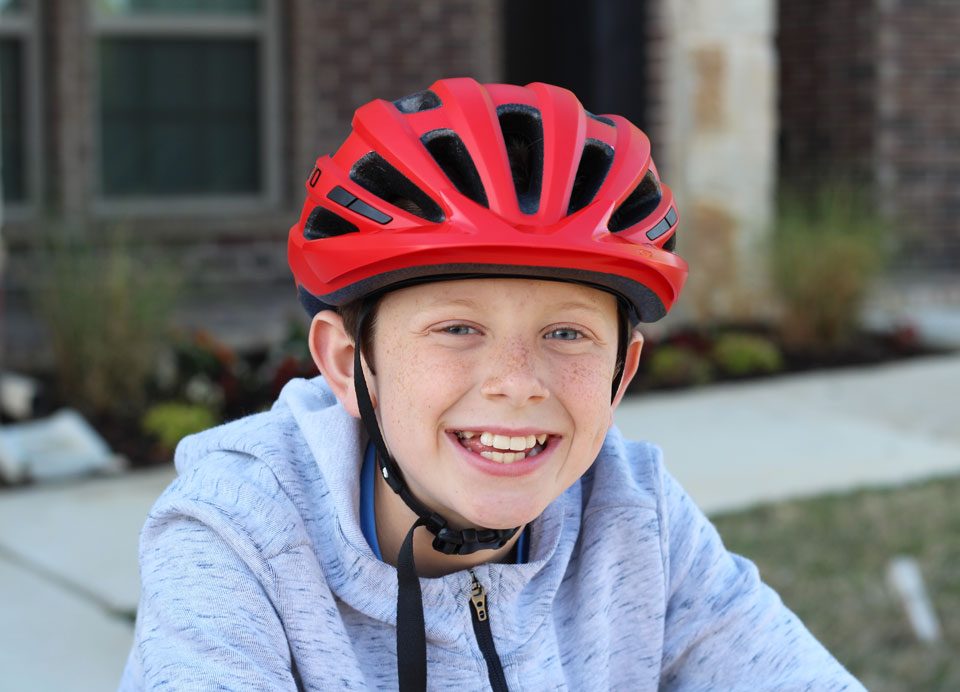
Giro Hale MIPS Overview

RATING: Exceptional
MSRP: $60 (Hale)
BEST FOR: Parents who want a lightweight youth helmet with MIPS technology
SIZE: 50 – 57 cm
ADJUSTMENT SYSTEM: Dial adjust
WEIGHT: 259 g
PROS:
- Super lightweight
- Tons of ventilation for keeping heads cool
- No side strap adjusters makes getting a perfect fit easy
- Dial-adjust system has a larger rubber dial for easy grabbing and twisting
- Internal pads are soft and high-quality sport material
- MIPS safety technology
CONS:
- Standard buckle
Giro Hale MIPS Youth Helmet – Results of our Test Rides
The Hale splashed onto the market in 2018 as an update on Giro’s older Raze helmet. It is now Giro’s only true cycling helmet offering for youth.
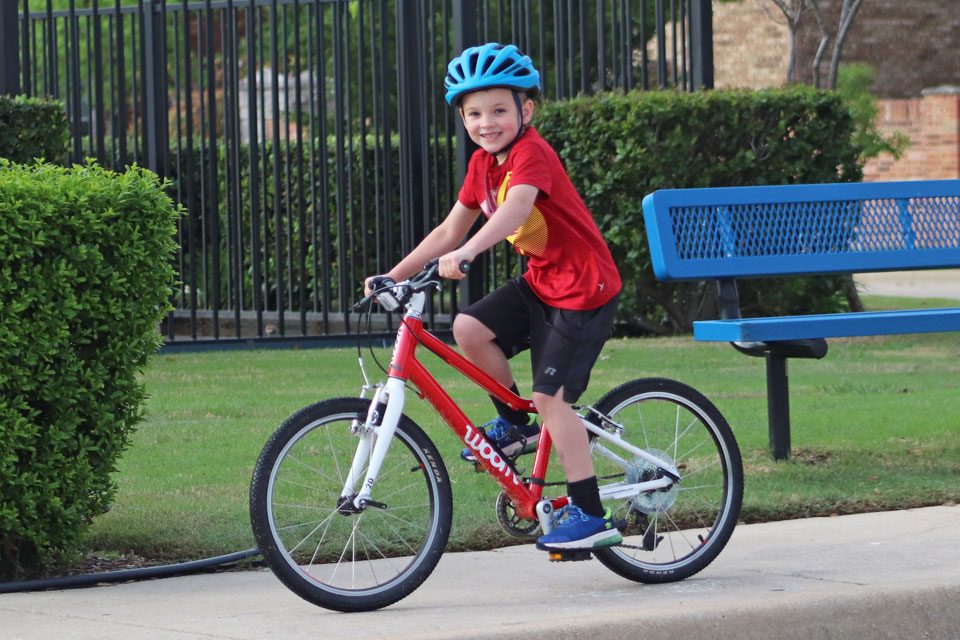
Size – Hale is Standard “Youth” Size
The Giro Hale is a standard “Youth” sized helmet that fits kids’ heads in the 50 – 57 cm circumference range. At its widest point, it’s 16.5 cm wide, just slightly smaller than the Bell Sidetrack at 17 cm. It’s incredibly important to remember that heads come in many different shapes. You could have two kids with a head circumference of 55 cm, but they many not be able to fit in the same helmet depending on how wide or tall their head is.
While the Bell Sidetrack’s sides narrow when the dial adjust knob is turned to make the helmet smaller, the sides are fixed on the Hale. So if your child’s head is a little wider than average, the Giro helmets would probably be the better choice. If your child has a very wide head, skater-style helmets like the Melon, are usually the route to go.
Adjustability – Dial-Adjust for a Snug Fit
To provide a proper helmet fit, any helmet worth buying should have an internal adjustment system. Giro’s Roc Loc adjustment system is A++ and is definitely a step up from the Sidetrack and most other helmets we’ve seen.
The dial adjust system of the Hale features a slightly larger dial that’s covered in a rubber grip to make it so much easier to adjust, especially when it’s already on a child’s head. (Please excuse the dirt, this helmet gets a lot of love!) The Sidetrack dial is harder to grip and also doesn’t dial in nearly as smoothly.

Pads – Sealed and Sweat-Wicking
While many higher-end helmets have traditionally come with multiple sets of pads of different thicknesses to better customize the fit for your child, it seems to be a trend to forgo the extra set of pads.
This keeps costs down, and also gives parents one less thing to worry about when adjusting the size of their child’s helmet. And while it may be nice to have a set of thinner pads to exchange out as your child grows, if you can manage to keep track of them that long, you’re far better parents than we are. 🙂

The Giro Hale Youth helmet is lined with high-end, sealed pads to prevent sweat from dripping down your child’s face, but also, the side that touches the skin is a high-end athletic performance material called Quick-Dry padding. These pads are definitely among the nicest we’ve seen and are an upgrade from the pads of the Bell Sidetrack, which are sealed but don’t feature the technical fabric.
Side Straps – No Adjusting Required!
Correctly adjusting the sliders on a helmet’s side straps is necessary for a helmet to stay centered on a child’s head. On most helmets, they can be difficult to get centered, and often slide out of place and have to be re-adjusted.
On the Giro Hale, the side straps don’t have plastic sliders because they are fixed into a permanent V and cannot be shifted out of place. This is such a help as its one less thing to worry about when putting your child’s helmet on their head. Additionally, the woven nylon is soft and smooth against the skin.
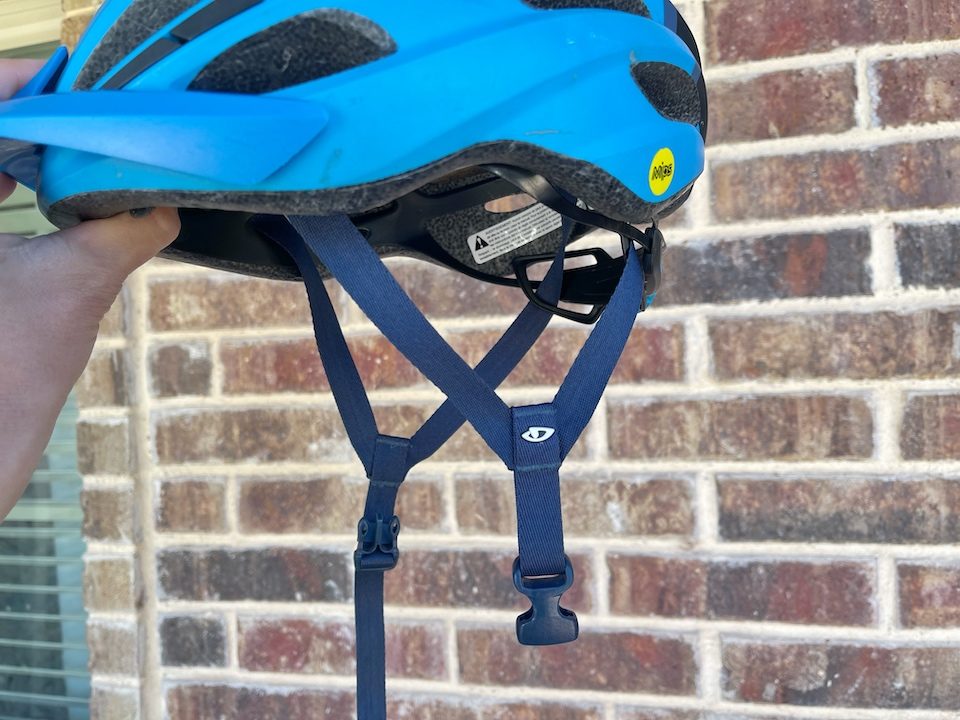
Basic Buckle on the Hale
The buckle on the Hale is a standard-style buckle. While more expensive helmets have magnetic buckles, that does add to the cost of a helmet.
MIPS Safety Technology Comes Standard on Giro Hale
The Giro Hale comes standard with MIPS (Multi-directional Impact Protection System), which allows the energy from a crash impact to be absorbed by the helmet’s inner foam core no matter what direction the impact is coming from.
This is possible because yellow MIPS anchors inside the helmet allow the helmet’s inner cage to slightly rotate upon impact. In the Giro Hale, the anchors are covered by the internal padding, which prevents hair from getting snagged on the anchors. Surprisingly, many high-end helmets have exposed MIPS anchors that easily snag hair! In the image below, I’ve folded down one of the pads to show the anchor underneath.

The Giro Hale’s plastic MIPS liner is integrated into the helmet’s internal dial-adjust cage. This allows for less plastic lining inside the helmet, which means a cooler helmet overall. In the summer, this can make a huge difference in your child’s comfort! Many other helmets, such as the Bell Sidetrack and Nutcase Little Nutty have much more expansive plastic MIPS lining inside the helmet.
Giro Hale vs. Tremor – How are they Different?
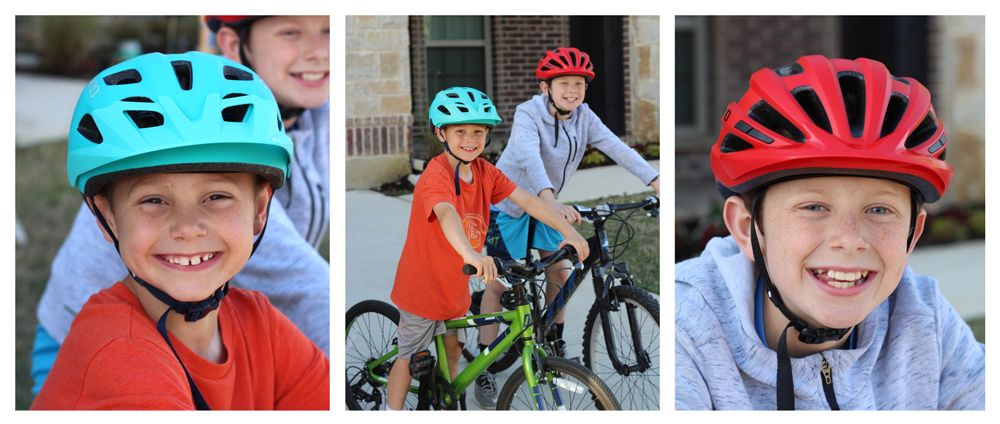
If you’re considering the Hale vs the Tremor, there are a few areas where they differ beyond just visual styling. All features mentioned previously are essentially the same between the Hale and Tremor. Below, we’ll focus on their differences.
Coverage – Hale Has Less Coverage
Because the Hale is a junior cycling helmet, it has slightly less coverage than the mountain bike styled Giro Tremor. The Tremor has more coverage in the back and sides, but both helmets provide plenty of coverage to keep your child’s head safe in the event of a crash.
Helmet Coverage – Tremor vs. Hale on 50.5 cm Head
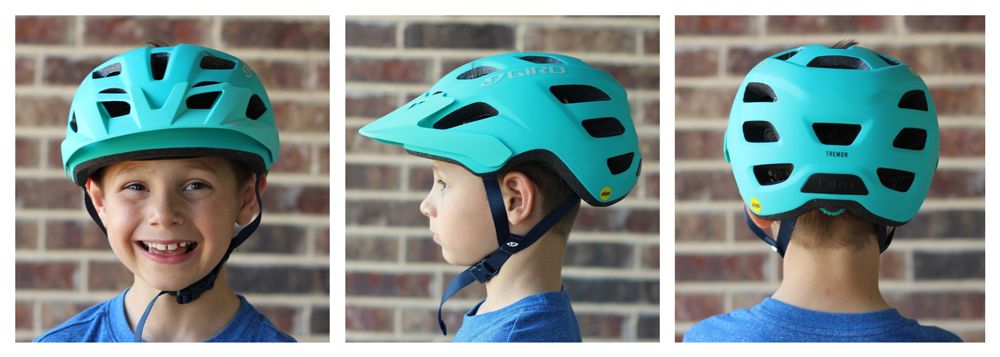

Weight – Giro Hale Weighs Less
Both the Giro Tremor MIPS and Giro Hale MIPS are super lightweight, but they do differ. With more coverage and less venting, the Tremor weighs 307 g while the Hale is one of the lightest weight helmets we’ve seen, at 247 g. The Tremor, however, does weigh about 14 g less than the similar Bell Sidetrack.
Construction
The Tremor and Hale feature in-mold construction which means that the outer shell is fused with the inner foam core so the helmet is one solid piece. This is the preferred type of helmet construction because it keeps quality high and the weight low.
The Hale does have slightly more coverage over its foam core than the Tremor. Exposed foam can get damaged more easily, so while still providing adequate protection, helmets that have more of the foam covered do have a bit more durability.
Slight Differences in Tremor, Hale, and Sidetrack Outershell Coverage

Visor – Giro Hale Visor is Shorter
The visor on the Tremor extends out farther than most visors we’ve seen, providing more protection from the sun. The visor on the Hale is much smaller, but is also consistent with other cycling helmets. Both are visors are removable.

Ventilation – Giro Youth Helmets Have Great Airflow
For superior ventilation, the Hale features 22 vents and 5 air channels running from front to back. If you live in a hot climate, the Hale should be high on your list of helmets to consider.
The Tremor also features 5 air channels, but only 18 vents. This is better, however, than the Sidetrack with just 15 vents.
Hale vs. Tremor: 22 vs. 18 Vents

Giro Hale MIPS Bottom Line
The Giro Hale MIPS Youth Helmet boast sweet styling and incredible quality. Comfortable and easy to use, it doesn’t get much better than the Giro Hale. When choosing between the Giro Hale and the Tremor, it really should just come down to which colors and designs your kid likes better!
To view an a full selection of helmets, check out our 10 Best Kids Helmets page.
FTC Disclosure: Affiliate links are included in this review. No monetary compensation was provided for this review. The product reviewed was purchased by Two Wheeling Tots and not supplied by the manufacturer. All opinions and images are that of Two Wheeling Tots LLC. All content and images are copyrighted and should not be used or replicated in any way. View our Terms of Use.
